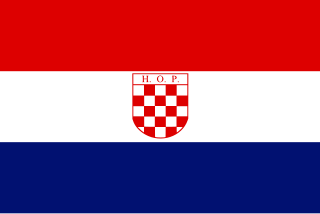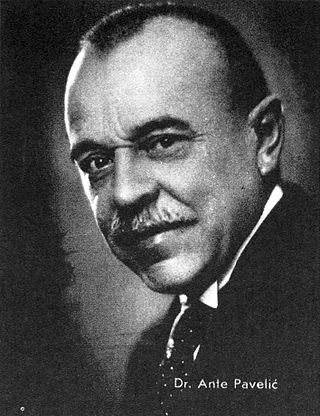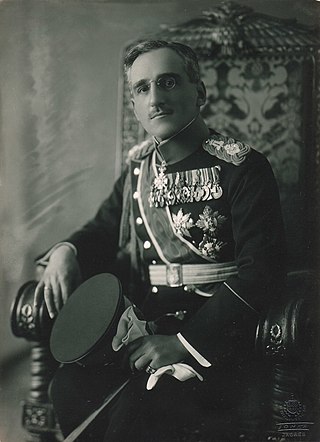
The Kingdom of Yugoslavia was a state in Southeast and Central Europe that existed from 1918 until 1941. From 1918 to 1929, it was officially called the Kingdom of Serbs, Croats, and Slovenes, but the term "Yugoslavia" was its colloquial name due to its origins. The official name of the state was changed to "Kingdom of Yugoslavia" by King Alexander I on 3 October 1929.
The Ustaše, also known by anglicised versions Ustasha or Ustashe, was a Croatian fascist and ultranationalist organization active, as one organization, between 1929 and 1945, formally known as the Ustaša – Croatian Revolutionary Movement. Its members committed regicide of the King of Yugoslavia, while later they also murdered hundreds of thousands of Serbs, Jews, Roma as well as Croatian political dissidents during World War II in Yugoslavia.

Ante Pavelić was a Croatian politician who founded and headed the fascist ultranationalist organization known as the Ustaše in 1929 and served as dictator of the Independent State of Croatia, a fascist puppet state built out of parts of occupied Yugoslavia by the authorities of Nazi Germany and Fascist Italy, from 1941 to 1945. Pavelić and the Ustaše persecuted many racial minorities and political opponents in the NDH during the war, including Serbs, Jews, Romani, and anti-fascists, becoming one of the key figures of the genocide of Serbs, the Porajmos and the Holocaust in the NDH.

The Independent State of Croatia was a World War II-era puppet state of Nazi Germany and Fascist Italy. It was established in parts of occupied Yugoslavia on 10 April 1941, after the invasion by the Axis powers. Its territory consisted of most of modern-day Croatia and Bosnia and Herzegovina, as well as some parts of modern-day Serbia and Slovenia, but also excluded many Croat-populated areas in Dalmatia, Istria, and Međimurje regions.

The State of Slovenes, Croats and Serbs was a political entity that was constituted in October 1918, at the end of World War I, by Slovenes, Croats and Serbs (Prečani) residing in what were the southernmost parts of the Austro-Hungarian Empire. Although internationally unrecognised, this was the first incarnation of a Yugoslav state founded on the Pan-Slavic ideology. Thirty-three days after it was proclaimed, the state joined the Kingdom of Serbia and the Kingdom of Montenegro to form the Kingdom of Serbs, Croats and Slovenes.
State of Slovenes, Croats and Serbs became merged with Kingdom of Serbia and Kingdom of Montenegro to form the nation of Yugoslavia in 1918. The formation of Yugoslavia began with the formation of the Yugoslav Committee, a collection of mostly Croats, then Serbs and later Slovenes, whose goal was to form a single south Slavic state. In October 1918 the Croatian Parliament declared the Kingdom of Croatia - Slavonia as an independent state, which, in December that same year, incorporated in State of Slovenes, Croats and Serbs, merged with Kingdom of Serbia and Kingdom of Montenegro and created the Kingdom of Serbs, Croats and Slovenes. The kingdom would be renamed to Yugoslavia in 1929, and ruled by Serbian Karađorđević dynasty till Second World War. After the formation of Yugoslavia, Serbia attempted to create a "Greater Serbia" by using police intimidation and vote rigging to establish a Serbian controlled Yugoslavia. From 1929-1941 Serbian controlled Yugoslavia established control over Croatia through Royal Yugoslav police force brutality and assassinations of important Croatians.

Ante Trumbić was a Yugoslav and Croatian lawyer and politician in the early 20th century.

Vladimir Maček was a politician in the Kingdom of Yugoslavia. As a leader of the Croatian Peasant Party (HSS) following the 1928 assassination of Stjepan Radić, Maček had been a leading Croatian political figure until the Axis invasion of Yugoslavia in 1941. As a leader of the HSS, Maček played a key role in establishment of the Banovina of Croatia, an autonomous banovina in Yugoslavia in 1939.

Croatian nationalism is nationalism that asserts the nationality of Croats and promotes the cultural unity of Croats.

The Croatian Liberation Movement is a minor far-right political party founded in 1956 in Buenos Aires, Argentina, by Ante Pavelić, poglavnik of the Independent State of Croatia and its ruling party Ustashe – Croatian Revolutionary Movement from 1941 to 1945, and some Croatian emigrants.
Parliamentary elections were held in the Kingdom of Serbs, Croats and Slovenes on 18 March 1923. The seats were divided up by the political borders which existed before the Kingdom's formation and distributed using the population statistics of 1910.
The Croatian Bloc or the Croatian National Representation was the name held by the wide coalition of Croatian political parties in the Kingdom of Serbs, Croats, and Slovenes from 1921 to 1929's 6th of January Dictatorship and within the Kingdom of Yugoslavia from 1935 to 1941.

Ante Pavelić was a Croatian and Yugoslav dentist and politician.
Juraj Krnjević was a Croatian politician who was among the leaders of the Croatian Peasant Party (HSS). He was the party's General Secretary since 1928 and President since 1964. He also served as the First Deputy Prime Minister and Minister of Post, Telegraph and Telephone of Yugoslavia between 1942 and 1943.

The 6 January Dictatorship was a royal dictatorship established in the Kingdom of Serbs, Croats and Slovenes by King Alexander I with the ultimate goal to create a Yugoslav ideology and a single Yugoslav nation. It lasted from 6 January 1929, when the king prorogued parliament and assumed control of the state, and ended with the 1931 Yugoslav Constitution.

Branimir "Branko" Jelić was an exiled Croatian nationalist and doctor of medicine. He was a member of the fascist Ustaše organization.

Mladen Lorković was a Croatian politician and lawyer who became a senior member of the Ustaše and served as the Foreign Minister and Minister of Interior of the Independent State of Croatia (NDH) during World War II. Lorković led the Lorković-Vokić plot, an attempt to establish a coalition government between the Ustaše and the Croatian Peasant Party and align the Independent State of Croatia with the Allies.
The Party of Rights was a Croatian nationalist political party in Kingdom of Croatia-Slavonia and later in Kingdom of Serbs, Croats and Slovenes.

Ante Vokić was a Croatian politician, general and putschist. Member of the Ustaše, he was the Minister of Armed Forces of the Independent State of Croatia from 29 January to 30 August 1944, succeeding Miroslav Navratil.
Operation Gvardijan was covert action of Yugoslav State Security Administration (UDBA) from 1947 and 1948. It prevented an attempt by Ustasha emigrants to carry out terrorist and diversionary actions in Yugoslavia and unite anti-communist Crusaders in the country, in an uprising against the new authorities.

















